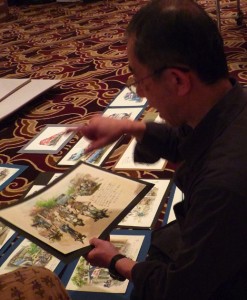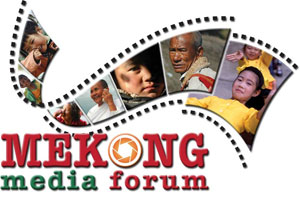Suvendrini Kakuchi interviews Japanese illustrator Akira Mizuno, whose fascination lies outside his native Japan – in South-east Asia and particularly the Mekong region, where “the zest and generous spirit of ordinary people” easily reminds him of the old Japan.
The illustrations of Mizuno, who has worked for major publishing houses in Japan, represent a style that relies on the simplest of tools that artists use — pencil and water colour. His refusal to abandon the old school is born of his “great nostalgia for old Japan”.
the simplest of tools that artists use — pencil and water colour. His refusal to abandon the old school is born of his “great nostalgia for old Japan”.
In an interview with TerraViva, he shares his thoughts on his pursuit of a style all his own and the philosophy behind it.
TerraViva: The work produced by Japanese cartoonists and illustrators have a huge following in South-east Asia and the rest of the world. How would you describe your job as an illustrator?
Akira Mizuno: I started work as an illustrator more than 30 years ago. At that time cartoons or ‘manga’, and illustrations were extremely popular in Japan and used widely in publications and the media. I worked in design companies at the beginning, producing various illustrations for books, magazines and newspapers, using many art tools for my work such as crayons, computer technology and paints.
The genre has gone through many stages of evolution during the past decades. One important emergence is the growth of sophisticated technology as cartoonists compete to produce more and more pictures rapidly as the demand grows.
I, however, have become less involved in the expanding ‘manga’ industry. I’ve chosen to work with my hand rather than delve into new technology, for I feel most comfortable with pencil sketching and water colours for my illustrations.
I am focusing heavily on bringing out the details of my portrayals. This means I am spending a lot of time creating each of my illustrations, which leaves me mostly out of the much revered and fierce competitive nature of the ‘manga’ boom.
TerrraViva: Would that mean you are developing your own style among Japanese illustrations?
AM: I prefer not to be referred to as a specialist in any style. My illustrations basically follow my philosophy, which is to respect the slowness of life and simple living and protect vanishing traditions and culture.
I am not against modernisation and economic growth at all. But as an older Japanese, I have seen the enormous changes in Japanese society following our so-called miracle postwar economic growth that made us one of the richest countries in the world. But the process seems to have left a certain kind of emptiness in Japanese society. We have lost our community life and our vitality for living. Materialism in the form of money and machines now rule our life. Speed is the most important thing for the Japanese.
In this change we are forgetting the little important gestures that make life so enjoyable — communicating and sharing with our neighbours, spending more time with our families. This is what I want to capture in my illustrations and I do this by using old-time tools.
TerraViva: Your illustrations of the Mekong region are well known in Japan. Why are you fascinated with the Mekong?
Mizuno: My illustrations of the Mekong represent exactly what I’m trying to do. The illustrations aim at bringing out the zest and generous spirit of the ordinary people in those countries.
During my travels in Vietnam, the beauty of life was portrayed vividly in the noisy side streets that were filled with shops, old-fashioned vehicles and people. The people spoke and shouted at each other without restraint. They were sharing food and stories of their lives without caring about what others were saying about them. This spirit brought to me great nostalgia for old Japan, where the community spirit was similar. So I thought I would draw the people on the side streets and show the pictures to the Japanese so they could also remember the past and try to bring back those heady days that were not ruled by looking for a steady job in a rich company and nothing else.
TerraViva: What are your best illustrations of Vietnam?
Mizuno: I am most interested in the tuk-tuk and cyclo. The vehicle symbolises much of what the Mekong is for me. The tuk-tuk is used a lot by ordinary people for their daily chores and is a sturdy vehicle that can travel anywhere. The drivers and the passengers chat freely with each other. The cyclo is another symbol of sharing between people. The cycle rider takes the passenger with him and the scene is a caring one. My Mekong illustrations bring these precious moments to the viewer.
TerraViva: Do you think illustrations can be used to carry important social messages?
Mizuno: In Japan, cartoons and illustrations have been used through the centuries. For example, in the 18th century, Japanese woodblock prints, or ‘ukiyo-e’, were used widely by artists to portray the free spirit of society at that time as well as different occupations.
In the 19th century when Japan turned to militarism that led the country into World War ll, ‘manga’ was a medium used by Japanese artists and writers who turned to cartoons when their written text was censored. The cartoons poked fun at the military – something that could never have been done in news media.
Today, the Japanese ‘manga’ brings to the world the lives and problems of the modern Japanese. ‘Manga’ developed by artists in the Mekong can be shared with the Japanese also so they can understand each other. It is a very effective communication tool in modern times. So, yes, illustrations are a powerful way of conveying a message.







